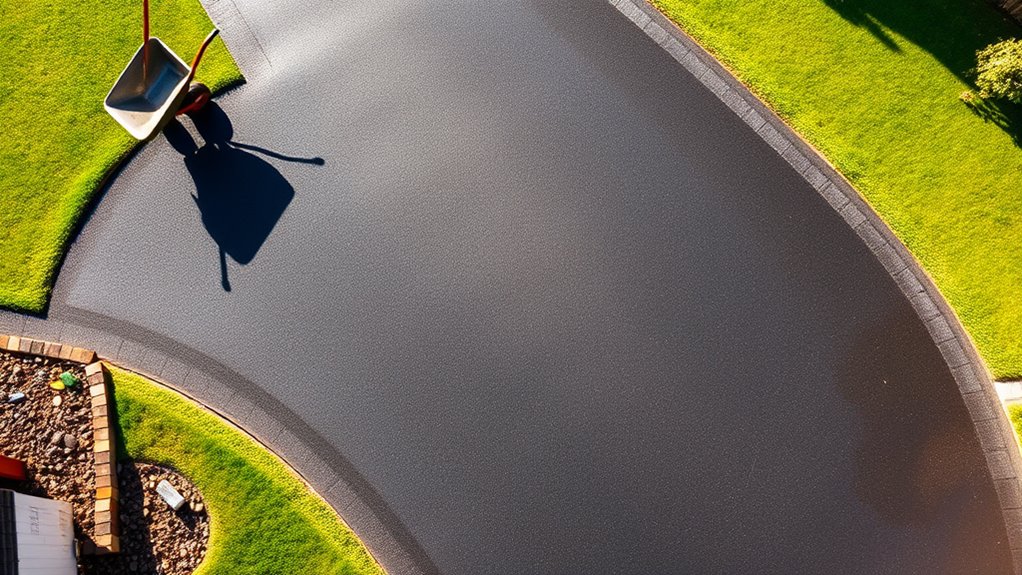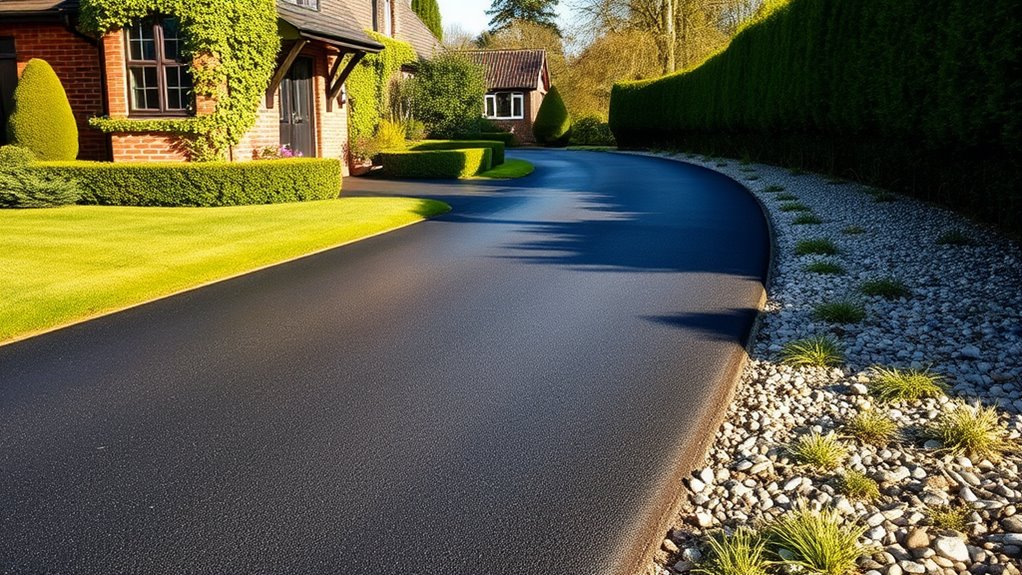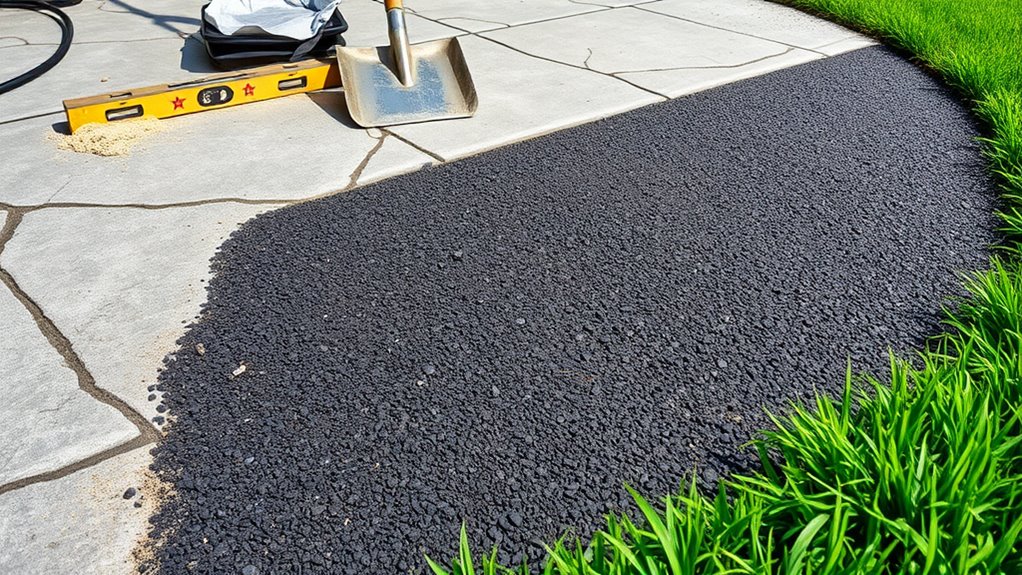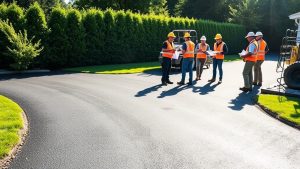You can install a driveway without needing planning permission, but it depends on its size, materials, and local regulations. Generally, if your driveway exceeds five square metres and uses non-permeable materials, you’ll require consent. Some properties, especially in conservation areas, have stricter rules. Always check with your local council to ensure you’re compliant, as ignoring this can lead to legal issues. It’s also worth considering the impact of your surface materials on drainage and the community.
Table of Contents
ToggleKey Takeaways
Planning permission is generally needed for new driveways over five square metres if you’re using non-permeable materials. You might be able to install some driveways without permission under Permitted Development Rights (PDR), but keep in mind there are restrictions on drainage and size. If you’re in a conservation area or near a listed building, the rules are stricter, and you’ll likely need permission.
It’s important to check with your local council before starting any driveway project, as they set the specific requirements for your area. Ignoring planning regulations can lead to legal troubles and hefty fines. Always better to be safe than sorry!
Understanding Planning Permission for Driveways

When planning to install a driveway, it’s important to grasp the details of planning permission to avoid any legal issues.
Planning permission ensures your driveway complies with local regulations, which often consider aesthetics and material choices. For example, if your driveway is larger than 5 square metres and uses non-permeable materials like concrete, you’ll require permission. Additionally, if you live in a conservation area or near a listed building, local authorities may have stricter rules that could affect your design. Always consult your local council before starting, as they’ve the authority to influence your plans. Understanding permitted development rights will help you determine if your installation can proceed without full planning permission. Being aware of these factors will help you steer clear of legal complications and ensure your driveway fits well within the neighbourhood. Planning permission is particularly crucial when creating a new access point from a public road, as this often requires approval.
When Is Planning Permission Required?
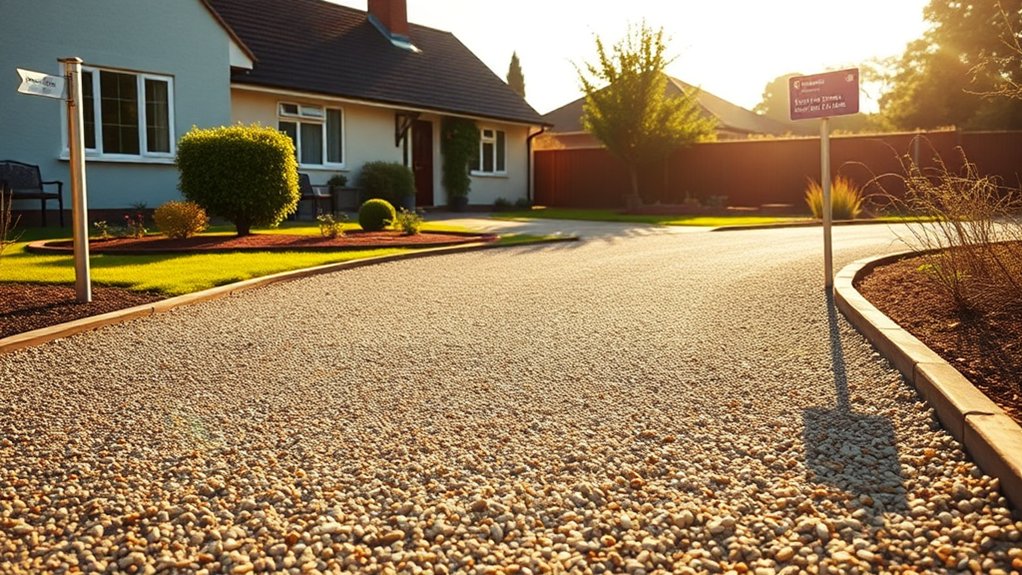
Generally, if you’re building a new driveway or creating a new access from a public road, you’ll likely need permission. If your driveway is larger than five square metres and made from non-permeable materials like tarmac or concrete, planning consent is usually required. Additionally, significant widening of an existing driveway or modifications that affect visibility on surrounding roads may also necessitate permission. It’s always best to check with your local planning authority to understand specific requirements, as they consider the potential impacts on road safety and drainage. Being compliant now can save you from costly issues later, especially since planning permission may be required for driveways that exceed certain specifications. Moreover, local zoning laws can dictate additional criteria that must be met before approval can be granted.
Permitted Development Rights Explained
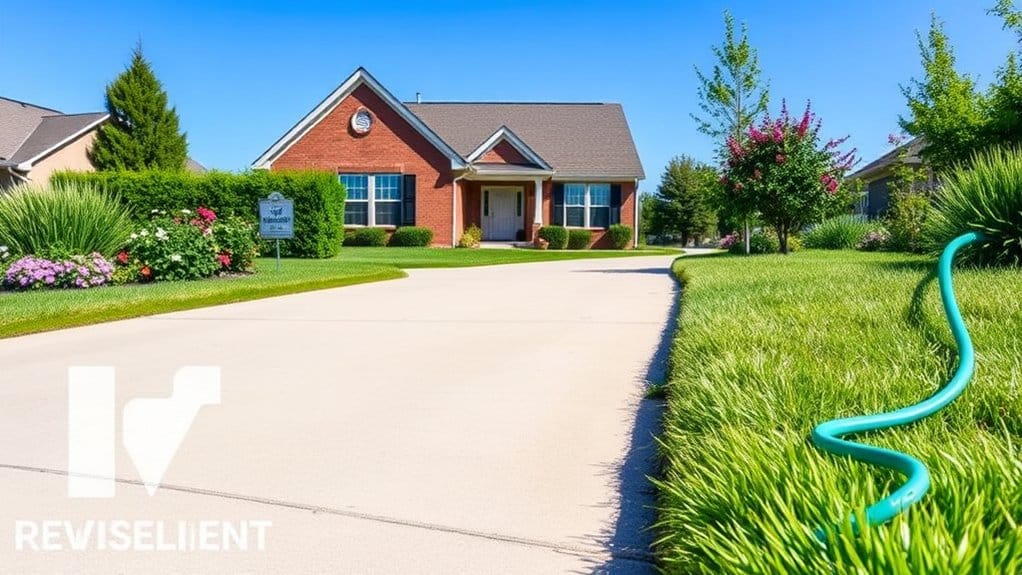
Permitted Development Rights (PDR) can make installing a driveway easier by allowing some projects to go ahead without needing planning permission. However, it’s crucial to consider certain conditions and limitations. For example, you must ensure that your chosen materials meet drainage requirements and adhere to size restrictions, particularly for non-porous surfaces. Proper drainage is essential to prevent surface water runoff, which can lead to flooding issues. Additionally, check for any local rules or property-specific limitations that might affect your eligibility for PDR. Some properties, such as those in listed buildings or conservation areas, may face additional restrictions that could impact your project.
Conditions for PDR
To install a driveway under Permitted Development Rights (PDR) in the UK, you must adhere to specific conditions.
Here are four important points to consider:
- The driveway must be located within the residential curtilage of your home.
- Changing the access point onto the public highway requires planning permission.
- Use permeable materials, such as gravel or porous blocks, to ensure proper drainage.
- Check for any existing access restrictions or prior planning consents that may affect your project.
Limitations and Exceptions
Installing a driveway under Permitted Development Rights (PDR) might seem simple, but there are important limitations and exceptions to consider.
PDR applies only to houses, excluding flats and commercial properties. Factors like size, design, materials, and location can significantly affect the look and functionality of your driveway.
If you’re thinking about using non-porous materials, you may need planning permission due to drainage issues and their environmental impact.
Local planning authorities can also impose stricter regulations, especially in conservation areas or designated zones. Moreover, creating new access points or modifying existing ones typically requires permission as well.
To ensure you’re compliant with all regulations, it’s always best to check with your local council before moving forward with your driveway project.
Exceptions to Permitted Development Rights
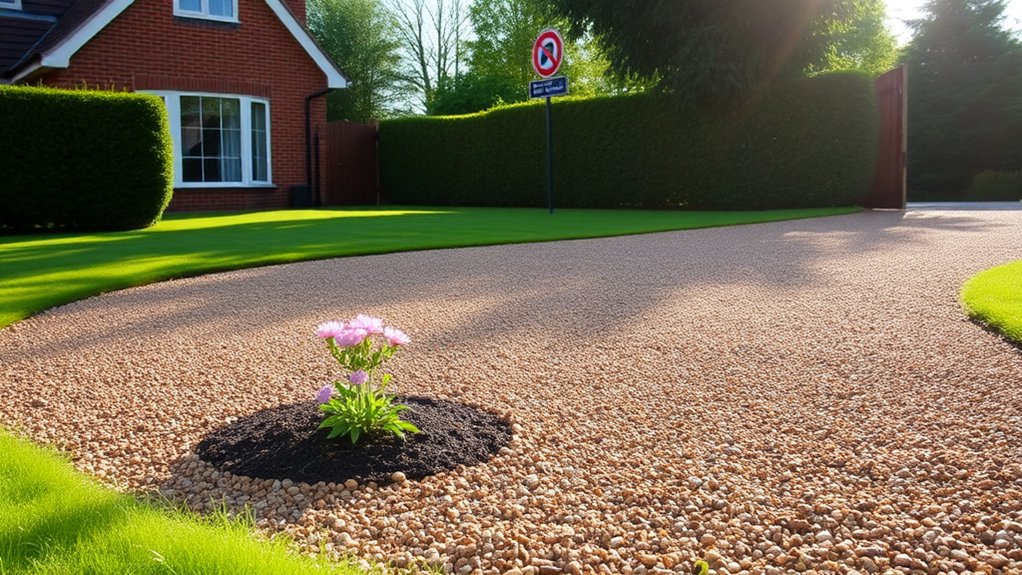
When looking into exceptions to permitted development rights, it’s important to consider conservation areas and listed buildings.
In these situations, you’ll likely need extra permissions, and the rules can differ significantly. For instance, if you live in a conservation area, the local council may have specific guidelines about materials and design for your driveway.
Always check with your local authority to ensure you comply with all requirements before starting your driveway installation.
Conservation Area Limitations
When considering a driveway in a conservation area, homeowners must navigate stricter regulations due to the area’s historical and architectural importance.
Key points to keep in mind include:
- Planning Permission: You may need to apply for planning permission, as permitted development rights might be removed.
- Design Compatibility: Your driveway’s design must fit the character of the area, which can limit your options.
- Access Approval: If you’re creating a new access point from a public road, it may require approval.
- Drainage Compliance: Ensure your drainage system meets local regulations to prevent flooding issues.
Failure to comply with these regulations can result in significant penalties.
Always consult your local planning authority before starting your driveway project, as preserving the historical value of your conservation area is crucial.
Listed Building Requirements
Installing a driveway at a listed building involves navigating strict regulations. Any significant external changes, such as driveway modifications, require both planning permission and listed building consent to protect the historical integrity of the property. Here’s what you need to know:
| Requirement | Planning Permission | Listed Building Consent |
|---|---|---|
| Applies to driveways | Yes | Yes |
| Permitted Development Rights | No | No |
| Environmental considerations | Yes (must be permeable) | Yes |
| Local authority consultation | Mandatory | Mandatory |
Because alterations to listed buildings can affect their character, it’s essential to consult your local planning authority before making any changes. Not securing the necessary permissions could result in expensive retrospective applications.
Surface Material Regulations and Their Impact
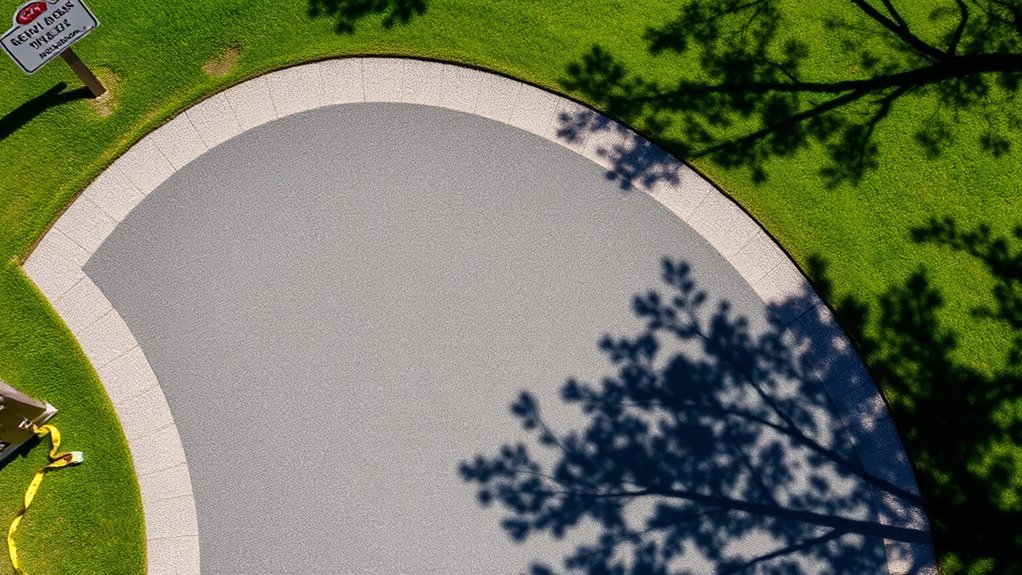
Understanding surface material regulations is crucial if you want to install a driveway without needing planning permission. Your choice of material can determine whether you need that approval.
Here are the key points to consider:
- Loose materials like gravel aren’t permitted near roads, as they can create hazards.
- For safety reasons, driveways should be constructed from bituminous or cement-bound materials.
- Permeable paving options, such as permeable concrete or cobblestones, often don’t require planning permission because they allow water to drain away.
- If you’re considering impermeable surfaces that exceed 5m², you’ll likely need permission to manage water runoff effectively.
Make sure to keep these guidelines in mind to ensure your driveway complies with local regulations.
Importance of Drainage and Flood Risk Management

When installing a driveway, proper drainage and flood risk management are essential. In the UK, if your driveway is larger than 5m², you must have effective drainage systems in place to meet legal requirements. This isn’t just a formality; it’s vital for preventing flooding and managing surface water runoff effectively.
Using permeable materials like gravel allows water to drain naturally, minimising the need for complex systems. You can also direct excess water to soakaways or natural areas such as gardens, which helps protect local ecosystems.
Local Authority Consultation: Why It Matters

Navigating the ins and outs of driveway installation goes beyond just managing drainage and flood risks; you must also engage with your local authority.
Understanding local regulations is crucial for ensuring your driveway complies with legal standards. Here’s why consulting matters:
- Permit Requirements: Local councils will inform you whether a permit is necessary depending on the location and materials of your driveway.
- Application Process: You’ll need to submit detailed plans that demonstrate your design adheres to local codes.
- Project Timeline: Consulting early allows you to factor in permitting timelines, helping you keep your project on schedule.
- Avoiding Legal Issues: Engaging with your local authority can prevent fines or orders to remove non-compliant driveways.
Legal Compliance and Retrospective Planning
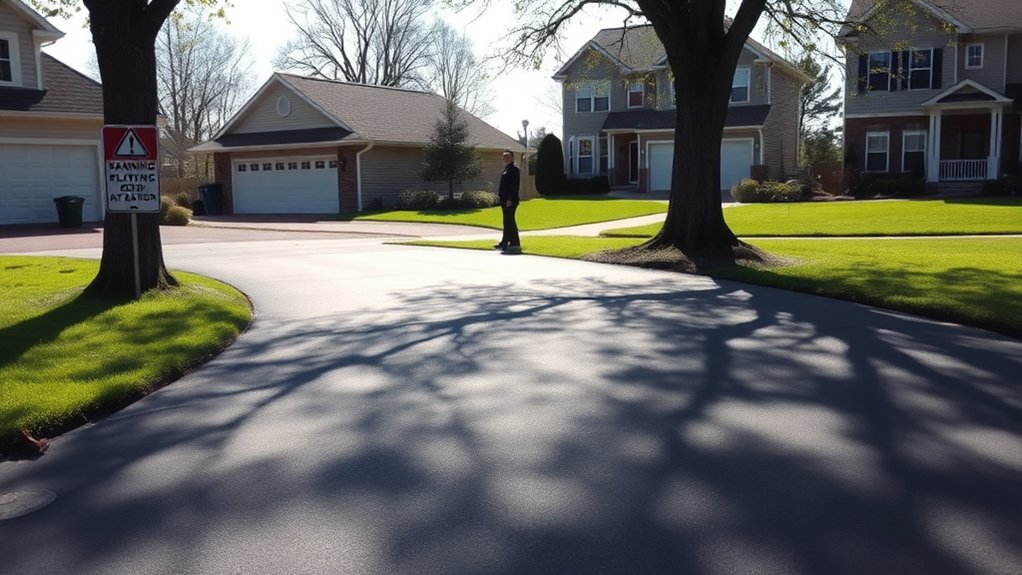
When installing a driveway, it’s crucial to know if you need planning permission to avoid legal complications.
If you go ahead without permission, you might run into difficulties when seeking retrospective approval, which can be both time-consuming and expensive.
Adhering to local regulations not only safeguards your investment but also helps maintain a good relationship with your neighbours.
For instance, if your driveway blocks access to a shared lane, it could lead to disputes.
Always check with your local council first to ensure compliance.
Planning Permission Necessity
Installing a driveway without the necessary planning permission can lead to serious legal issues. Here are key points to keep in mind to ensure compliance with safety regulations and maintain the look of your driveway:
- New Access Points: If you’re creating a new entrance to a public road, you’ll usually need permission.
- Surface Material: Using non-permeable materials for an area over five square metres requires planning approval to help prevent flooding.
- Widening Existing Driveways: If you’re making significant changes, especially affecting boundary features, you may need permission.
- Visibility Concerns: Any alterations that impact visibility for road users will require planning permission to maintain safety standards.
Being aware of these requirements can help you avoid legal troubles and ensure your driveway meets local regulations while looking good.
Retrospective Approval Challenges
Many homeowners underestimate the importance of obtaining planning permission before installing a driveway.
However, the challenges of getting retrospective approval can be considerable. These challenges often stem from the complexities of planning applications, particularly in relation to compliance with current regulations and local policies.
If your retrospective application is rejected, you could face enforcement actions such as fines or even orders to remove the driveway. Local authorities pay close attention to factors like drainage and permeability, and any failure to follow established guidelines increases the chances of your application being denied.
Even if your driveway has been in place for four years, don’t assume you’ll automatically receive approval; enforcement outcomes can vary widely.
Acting swiftly after an unauthorised installation is crucial to minimise risks and avoid potentially expensive legal issues in the future.
Impact of Driveway Alterations on Neighbours
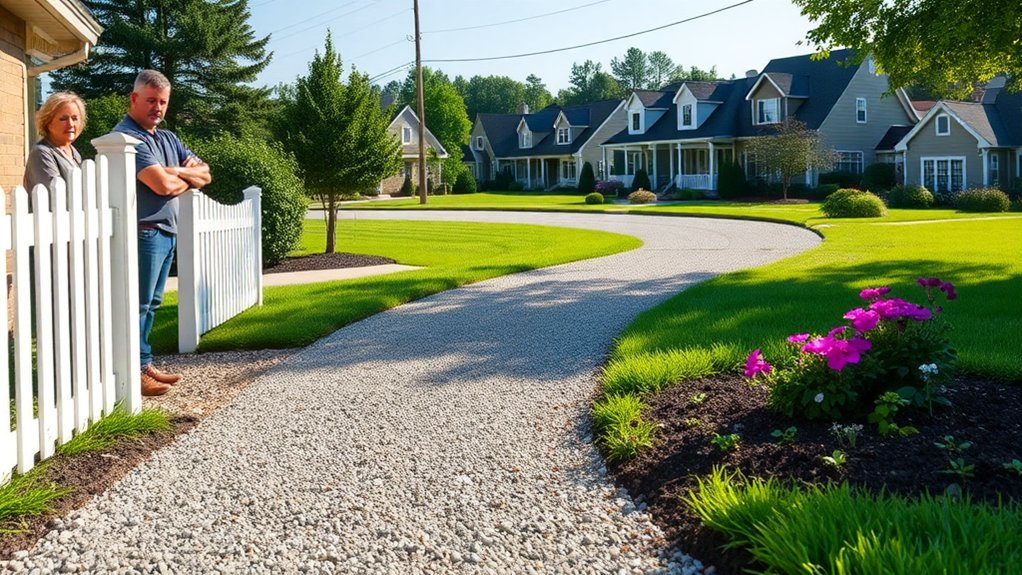
Driveway alterations can significantly affect your neighbours, especially if they infringe on shared boundaries or change access routes. Here are some key considerations:
- Boundary disputes: Building over your neighbour’s property can lead to disagreements or even legal action.
- Access issues: Modifications might interfere with your neighbour’s traffic flow and parking, resulting in conflicts.
- Safety hazards: Changing access points near busy roads can create visibility problems, which may raise safety concerns.
- Environmental impact: Alterations might disrupt drainage, potentially causing water runoff issues for your neighbours.
It’s wise to involve your neighbours early in the planning process. This can help prevent disputes and promote good community relations, making everyone feel considered in your driveway project.
Special Conditions for Listed Buildings and Conservation Areas

When planning alterations to a driveway for a listed building or in a conservation area, you need to follow specific regulations aimed at preserving historical significance and community character.
Even minor changes often require planning permission due to the property’s historical context. Local councils may implement Article 4 directions to ensure modifications fit the building’s architectural style.
It’s also important to design driveways with environmental considerations in mind to avoid issues like flooding and pollution.
In conservation areas, expect stricter design controls and possible community input.
To ensure compliance and maintain both the building’s integrity and the surrounding environment, it’s wise to consult with local authorities early in the process.
Considerations for Electric Car Charging and Driveway Design
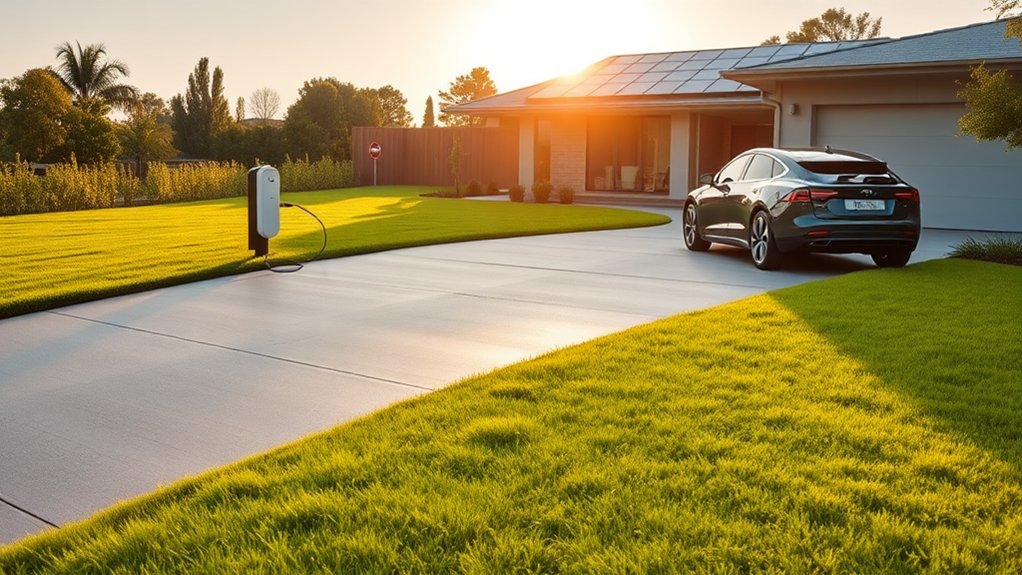
As electric vehicles (EVs) become more common, it’s important to incorporate charging solutions into your driveway design.
Here are some key considerations:
- Charging Infrastructure: Ensure charging points are positioned for easy access and comply with local regulations.
- Future-Proofing: Consider installing conduit during the build phase to make adding chargers simpler in the future.
- Surface Materials: Opt for sustainable options like permeable paving, which helps with rainwater drainage and minimises flood risks.
- Electrical Safety: Follow electrical safety standards and check whether you need separate permits for wiring and installations.
Frequently Asked Questions
Can I Install a Driveway if My Property Is a Flat?
You cannot install a driveway for your flat without adhering to specific regulations. If your property has communal spaces, you’ll need planning permission to ensure you comply with local authority rules. This is important to avoid any legal issues or unexpected costs. For example, if you share a parking area with neighbours, you’ll likely need their consent and approval from your local council. Always check the rules before proceeding.
What Are the Penalties for Building Without Planning Permission?
Building without planning permission can lead to significant consequences, including hefty fines and legal action. You might receive a stop-work order, which halts your project, or even a demolition notice if your building contravenes regulations. Additionally, your property’s value could decline due to unauthorised alterations. It’s crucial to grasp these risks before starting any construction work.
Do I Need Permission for a Temporary Driveway?
If you’re thinking about installing a temporary driveway, it’s important to check the local regulations. Using permeable materials may exempt you from needing planning permission, but you should always verify the specific conditions in your area that could impact your project. For instance, if you’re in a conservation area, additional rules might apply. Always do your homework before proceeding.
Can I Use Gravel for a Large Driveway Without Permission?
You can use gravel for a large driveway without needing permission, provided you follow the relevant regulations. Ensure that you meet drainage requirements to prevent water runoff and comply with environmental standards. For instance, consider how your driveway will affect neighbouring properties and local wildlife.
How Long Does It Take to Get Planning Permission for a Driveway?
The planning process for a driveway usually takes around eight weeks. However, factors such as consultations and environmental issues can extend this timeframe. For instance, if your drive impacts local wildlife or requires neighbour consultations, expect potential delays. Be ready for these possibilities as you navigate the approval process.
Conclusion
In conclusion, while you may think you can install a driveway without planning permission, it’s crucial to understand the regulations. Approximately 20% of homeowners encounter planning permission issues when making changes to their driveways. This underscores the need to check if your project falls under permitted development rights or if it requires special consideration. Always refer to local guidelines to avoid legal complications, particularly if your property is in a conservation area or near listed buildings.
How can a tarmac driveway enhance your home's appeal? Discover the key aspects of cost, installation, and maintenance in our Read more
Wondering if a tarmac driveway is the perfect fit for your home? Uncover the essential pros and cons before making Read more
Not sure if you can lay tarmac over your existing driveway? Discover the crucial steps and benefits you need to Read more


